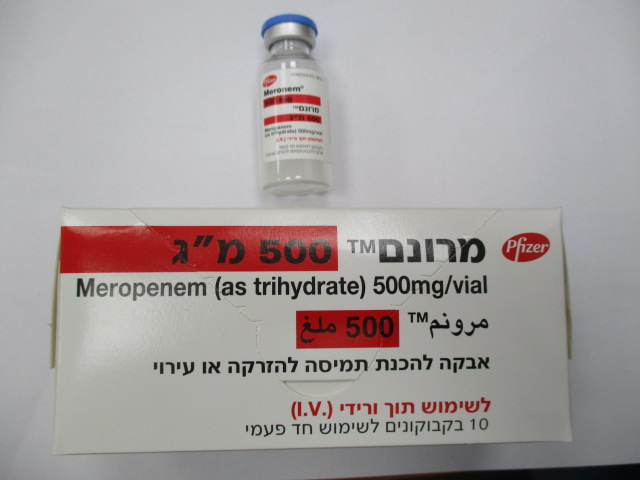Quest for the right Drug

מרונם 500 מ"ג MERONEM 500 MG (MEROPENEM AS TRIHYDRATE)
תרופה במרשם
תרופה בסל
נרקוטיקה
ציטוטוקסיקה
צורת מתן:
תוך-ורידי : I.V
צורת מינון:
אבקה להמסה להזרקהאינפוזיה : POWDER FOR SOLUTION FOR INJ/INF
עלון לרופא
מינוניםPosology התוויות
Indications תופעות לוואי
Adverse reactions התוויות נגד
Contraindications אינטראקציות
Interactions מינון יתר
Overdose הריון/הנקה
Pregnancy & Lactation אוכלוסיות מיוחדות
Special populations תכונות פרמקולוגיות
Pharmacological properties מידע רוקחי
Pharmaceutical particulars אזהרת שימוש
Special Warning עלון לרופא
Physicians Leaflet
Special Warning : אזהרת שימוש
4.4 Special warnings and precautions for use The selection of meropenem to treat an individual patient should take into account the appropriateness of using a carbapenem antibacterial agent based on factors such as severity of the infection, the prevalence of resistance to other suitable antibacterial agents and the risk of selecting for carbapenem-resistant bacteria. Enterobacteriaceae, Pseudomonas aeruginosa and Acinetobacter spp. resistance Resistance to penems of Enterobacteriaceae, Pseudomonas aeruginosa and Acinetobacter spp. varies across the European Union. Prescribers are advised to take into account the local prevalence of resistance in these bacteria to penems. Hypersensitivity reactions As with all beta-lactam antibiotics, serious and occasionally fatal hypersensitivity reactions have been reported (see sections 4.3 and 4.8). Patients who have a history of hypersensitivity to carbapenems, penicillins or other beta- lactam antibiotics may also be hypersensitive to meropenem. Before initiating therapy with meropenem, careful inquiry should be made concerning previous hypersensitivity reactions to beta-lactam antibiotics. If a severe allergic reaction occurs, the medicinal product should be discontinued and appropriate measures taken. Severe cutaneous adverse reactions (SCAR), such as Stevens-Johnson syndrome (SJS), toxic epidermal necrolysis (TEN), drug reaction with eosinophilia and systemic symptoms (DRESS), erythema multiforme (EM) and acute generalised exanthematous pustulosis (AGEP) have been reported in patients receiving meropenem (see section 4.8). If signs and symptoms suggestive of these reactions appear, meropenem should be withdrawn immediately and an alternative treatment should be considered. Antibiotic-associated colitis Antibiotic-associated colitis and pseudomembranous colitis have been reported with nearly all anti-bacterial agents, including meropenem, and may range in severity from mild to life threatening. Therefore, it is important to consider this diagnosis in patients who present with diarrhoea during or subsequent to the administration of meropenem (see section 4.8). Discontinuation of therapy with meropenem and the administration of specific treatment for Clostridium difficile should be considered. Medicinal products that inhibit peristalsis should not be given. Seizures Seizures have infrequently been reported during treatment with carbapenems, including meropenem (see section 4.8). Hepatic function monitoring Hepatic function should be closely monitored during treatment with meropenem due to the risk of hepatic toxicity (hepatic dysfunction with cholestasis and cytolysis) (see section 4.8). Use in patients with liver disease: patients with pre-existing liver disorders should have liver function monitored during treatment with meropenem. There is no dose adjustment necessary (see section 4.2). Direct antiglobulin test (Coombs test) seroconversion A positive direct or indirect Coombs test may develop during treatment with meropenem. Concomitant use with valproic acid/sodium valproate/valpromide The concomitant use of meropenem and valproic acid/sodium valproate/valpromide is not recommended (see section 4.5). Meronem contains sodium. Meronem 500 mg: This medicinal product contains 45 mg sodium per 500 mg vial, equivalent to 2.25% of the WHO recommended maximum daily intake of 2 g sodium for an adult. Meronem 1 g: This medicinal product contains 90 mg sodium per 1 g vial, equivalent to 4.5% of the WHO recommended maximum daily intake of 2 g sodium for an adult.
Effects on Driving
4.7 Effects on ability to drive and use machines No studies on the effect on the ability to drive and use machines have been performed. However, when driving or operating machines, it should be taken into account that headache, paraesthesia and convulsions have been reported for meropenem.

שימוש לפי פנקס קופ''ח כללית 1994
לא צוין
תאריך הכללה מקורי בסל
01/03/2001
הגבלות
תרופה מוגבלת לרישום ע'י רופא מומחה או הגבלה אחרת
מידע נוסף
